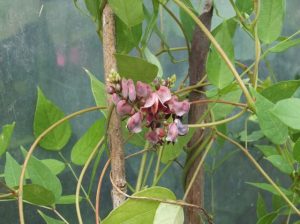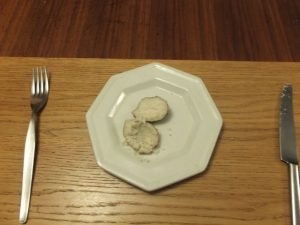Apios is one of those forgotten greenhouse gems seldom come across nowadays. It was once very popular in late Victorian times for the violet scent from the small racemes of purplish flowers. However after the First World War the shortage of labour and its slight tenderness made this plant unattractive. Indeed in the UK it lives outdoors only in the west where slightly warmer winters from the Gulf stream allow it to survive.

Apios tuberosa / americana as the name suggests comes from North America and was originally called Glycine apios. It’s from the Leguminosae and so provides its own nitrogen from micro-organisms on its roots and a lack of these can result in poor growth. Fortunately it’s normally grown from small tubers not seed and these bring the right bugs in with them. I have found growing peas in the same pots stimulates poorly specimens to produce better growth.
The actual culture is dead easy. You plant small tubers in pots of leaf mould rich (and not limey) compost, water well and train the resulting shoots up sticks or strings. The pots can be quite small but larger ones give much better results. The shoots are annual and die back so this is a safe plant to let clamber over larger perennials especially as the delicate pinnate leaves do not create much shade (and they close up if the plants get too dry or hot).
The climbing shoots of light foliage are attractive enough but it’s the wistaria like flowers that are so delightful and these are produced and last many weeks, probably as they’re not fertilised (I have never had them set seed). I suspect they lack a specific pollinator, or maybe you need unrelated plants. Anyway it matters not as flowers that do not set stay fresh longer. And that violet scent is so delicious if somewhat fugitive (smell it best on cool evenings).
But there is another reason you may wish to grow Apios. The tubers are edible, and the closest in taste and texture of any potato alternative. Admittedly the size could be improved as the majority of new ones (formed on a chain) are smallish but those re-planted in spring become larger each year and not discernibly tougher.

In fact these egg sized tubers are really quite palatable and may have been another reason for Apios’ drift into obscurity as two World Wars and the resultant food shortages would have made these too good to pass over.
The Delaware native Americans called these tubers hopniss and it’s said they helped the Pilgrim fathers to survive by showing them how to find these ‘ground nuts’ of their ‘wild bean’ their first winter.


